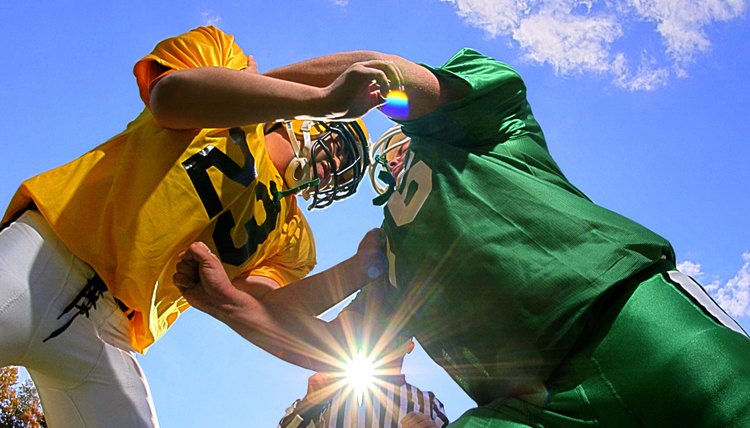What Are the College Football Defensive Holding Rules?

Even in a physical game such as college football, there are rules against being too physical. Whether on offense or defense, players are not allowed to use their hands to hook, lock, clamp, grasp, or hold in an effort to restrain the opponent. A defender can only make contact with an offensive player away from the ball within the blocking zone – the first five yards from the line of scrimmage. If any restraint is made beyond that, a defensive holding penalty can be called.
NCAA Rule 9-3-4
In the 2009-10 edition of the NCAA Football Rulebook, Rule 9 covers “Conduct of Players and Others Subject to the Rules.” Section 3 covers “Blocking, Use of Hands or Arms” and Section 4 is directed at defensive players. Section 3, Article 4 of Rule 9 states that a “defensive player may use hands and arms to push, pull, ward off or lift offensive players when attempting to reach the runner.” But they may not use hands and arms to tackle, hold or otherwise illegally obstruct an opponent other than a ball carrier. This is, by definition, defensive holding and carries a 10-yard penalty that is awarded to the offense as well as an automatic first down.
Differs from Pass Interference
Put simply, a pass needs to have been thrown in order for defensive pass interference to occur. Defensive holding occurs in the time before the quarterback releases the ball.
Rule 7-3-8 states that “defensive pass interference is contact beyond the neutral zone by a defensive player whose intent to impede an eligible opponent is obvious and it could prevent the opponent the opportunity of receiving a catchable forward pass.” The penalty for pass interference is an automatic first down and the yardage to the spot of the foul with a maximum of 15 yards from the previous line of scrimmage.
Blocker Becomes Receiver
After the ball has been snapped, the defender may make contact with an offensive player within the blocking zone. Defensive players may use hands and arms to push, pull, and ward off offensive players obviously attempting to block them. If an offensive player is reported as an eligible receiver before the play, the defensive player must break contact with that player after five yards.
Non-Passing Defensive Holding
A defensive lineman cannot hold an offensive lineman thus preventing him from pulling and leading interference on an outside running play. A defender cannot prevent a running back or receiver from advancing downfield beyond the blocking zone. A defender may jam the offensive player at the line of scrimmage, using legal hand movements, but must release them after five yards. A defender may not intentionally restrain an opponent from recovering a loose ball or fumble.
Exceptions
Whenever a forward pass has been touched by any player or official – for example, a deflection – the defensive player legally may ward off an opponent from the ball by any legal means.
Defensive players may use hands and arms to push, pull, ward off or lift offensive players who are obviously attempting to block them and when attempting to reach the ball carrier.
References
- NCAA Publications: 2009-2010 NCAA Football Rules and Interpretations
- NFL: Rulebook: Penalty Summaries
- “Sports Illustrated: The College Football Book”, Editors of Sports Illustrated, 2008
Writer Bio
Brian Lewis began writing in 1998. His published works appear in the "Ellensburg Daily Record," "South County Journal," "Seattle Times" and "Northwest Anglers" as well as on ESPN.com. Lewis has written concert and travel reviews and poetry and short stories. He has a Bachelor of Arts in communications from the University of Washington.
